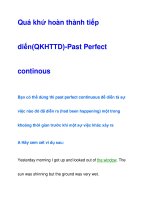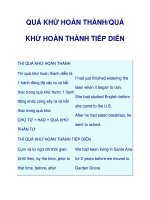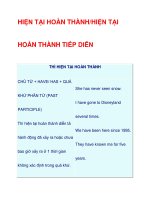Past Perfect Continuous - Quá khứ Hoàn thành Tiếp diễn pdf
Bạn đang xem bản rút gọn của tài liệu. Xem và tải ngay bản đầy đủ của tài liệu tại đây (48.63 KB, 3 trang )
Past Perfect Continuous - Quá khứ Hoàn thành Tiếp diễn
FORM of Past Perfect Continuous
The Past Perfect Continuous has two parts: the past perfect of the verb to be (=had
been) + the present participle (V-ing) of the main verb. See examples below.
S + had + been + V-ing
I had been learning English.
He had been swimming well.
They had been watching TV.
S + had not + been + V-ing
I hadn't been learning English.
He hadn't been swimming well.
They had not been watching TV.
Had + S + been + V-ing
Had you been learning English?
Had he been swimming well?
Had they been watching TV?
The Past Perfect refers to an action happened in the past and continued until
another action happened. But the speaker is more interested in the process of the
action.
USEs of Past Perfect Continuous
1. to describe an action started in the past and continued up until another
time or action in the past.
He had been playing game for over an hour before Tony arrived.
She had been applying for that company for three years when it went out
of business.
How long had you been waiting to get on the train?
Mike wanted to sit down because he had been standing all day at work.
James had been teaching at the university for more than a year before he
left for Asia.
How long had you been studying Turkish before you moved to Ankara?
2. Cause of something in the past
Using the Past Perfect Continuous before another action in the past is to show
cause and effect.
Tom was tired because he had been exercising for hours.
I failed the exam because I had not been attending the class.
Forms of Negatives and Questions
Negative sentences and questions are formed with the auxiliary verb 'had'.
He hadn't been sleeping until his mother came in.
Had she been trying to get good mark?









